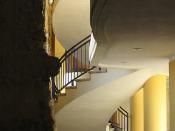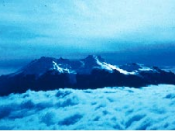Colombia Colombia's conventional long form name is The Republic of Colombia. It has a republic government, with the executive branch running the government structure. The capital is Bogota. They received independence from Spain on July 10, 1810 and that is it's national holiday also. The constitution was made up in July 5, 1991. It is a country in South America. Colombia was one of three countries to emerge from the collapse of Gran Colombia in 1830. The other two were Venezuela and Ecuador. After a 40 year insurgent campaign to overthrow the government escalated in the 1990's, getting funded from the drug trades. Fighting and violence has been breaking out and has made neighboring countries concerned about the violence spilling over into their country.
Colombia is bordered by the Pacific Ocean, Venezuela, Ecuador, Peru, Brazil, and the Caribbean Sea. It is the only South American country with coastlines on both the North Pacific Ocean and Caribbean Sea.
A Colombian peso is equal to 100 centavos. The total area of Colombia is 1,138,910 sq. km. The land area is 1,038,700 sq. km. The water area is 100,210 sq. km. In size Colombia is slightly less than 3 times the size of Montana.
The climate of Colombia is mostly tropical along the coast and the eastern plains, but cooler when you get into the highlands. The terrain is flat in the coastal lowlands, central highlands, the high Andes Mountains, and eastern lowland plains. The lowest point is at the Pacific Ocean at 0 m. The highest point is Nevado del Huila at 5,750 m. Some of the natural resources are petroleum, natural gas, coal, iron, ore, nickel, gold, copper, emeralds, and hydropower. Colombia's current natural hazards are highlands subject to volcanic eruptions, occasional earthquakes, and periodic droughts. Some current environment issues are the deforestation, soil damage from overuse of pesticides, air pollution mainly in Bogota, from the vehicle emissions.
Colombia's population as of July 2000 is 39,685, 655. People ages 0-14 made up 32%, ages 15-64 made up 63%, and ages 65 years and up made up 5%. The population growth rate is rising at 1.68%. The birth rate is at 22.85 births/1,000 population. The death rate is at 5.73 deaths/1,000 people. The migration rate has gone down in the past years though.
The life expectancy for the country is at 70.28 years, for males it is at 66.43 years, and for females it is at 74.27 years. The ethnic groups that make up Colombia are: mestizo 58%, white 20%, mulatto 14%, black 4%, mixed black-Amerindian 3%, and Amerindian 1%. The main religion is Roman Catholic at 90% of the population. All of Colombia speaks Spanish.
Colombia's economy is poised for moderate growth in the next several years, marking an end to the severe 1999 recession. President Pastrana has put together a well-respected economic team, which is taking steps to make sure the recovery is successful. The inflation rate in Colombia is at 9.2% as of 1999. Some of the bad news is that the unemployment rate has reached a new high at 20%. Some of the industries are textiles, food processing, oil, clothing and footwear, beverages, chemicals, cement, gold, coal, and emeralds.
The main agriculture products are coffee, cut flowers, bananas, rice, tobacco, corn, sugarcane, cocoa beans, oilseed, and vegetables. The country has export partners such as the U.S., Japan, and Europe. The commodities are petroleum, coffee, coal, gold, bananas, and cut flowers. The import partners are the U.S., Japan, and Europe also. Its commodities are industrial equipment, consumer goods, chemicals, paper products, fuels, and electricity. They have a 35 billion dollar debt, but they only receive a 40.7 million dollar economic aid.
The military in Colombia is made up of the Army, Navy, Air Force, and the National Police. Even though they have this type of military Colombia still elicit many drugs such as coca, opium poppies, and cannabis. It is the world's leading coca cultivator, and a supplier of heroin to the United States.
The transportation is mainly in the highways. They do have many waterways and airports though. They have 1,101 airports but out of that many only 90 of them have paved runways and 1,011 of them have unpaved runways. The communications are mainly by phone but they do have some internet access, television, and radios.
Colombia makes as a good country. It is trying to bring itself back from hard times, but new one's keep on coming such as a high rate of unemployment and all of the illicit drugs that are being made for money. President Pastrana is doing a good job trying to keep their country together and it should keep the peace between the other countries surrounding it. Colombia. Encyclopedia Britannica. (1990). Vol. 3. 460-461.
Raymond Leslie Williams., & Kevin G. Guerrrieri. (1999). Culture & Customs of Colombia. Greenwood press.
Retrieved January 17, 2002, from http://education.yahoo.com/reference/factbook/co/econom.html.
Retrieved January 17, 2002, from http://www.colombia.com Retrieved January 17, 2002, from http://dailynews.yahoo.com/herum/20020104/wl/colombia_peace_dc_l.html.
Retrieved January 17, 2002, from http:// www.tribune.atfreeweb.com/extract19012001.htm Tricia Haynes (1985). Lets Visit Colombia. Burke Publishing



